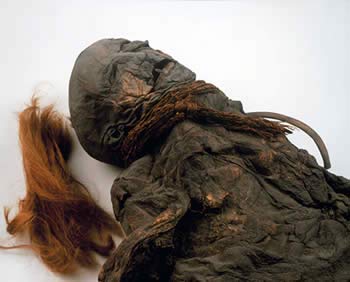See the Mysterious 'Bog People'

PITTSBURGH (AP) -- The seven mummies on display at the Carnegie Museum of Natural History are nowhere near as famous as King Tut, but they are just as intriguing.
Take the 2,000-year-old body of a teenager, found in the Netherlands. Who was she? Who killed her and why? She certainly was killed; the remains of the cord used to strangle her are still visible around her neck, a century after she was found in a peat bog. Was the killing of "Yde Girl'' a punishment, or ritual?
The exhibit, "The Mysterious Bog People,'' makes the case for ritualistic sacrifice as it delves into the early history of northwestern European life around bogs through archaeology and forensic sleuthing befitting a "CSI'' episode.
In fact, part of the exhibit, Bog Science Investigation, allows visitors to investigate four hypothetical bog bodies.
Visitors can examine bones, skull, and teeth (don't worry, they're fake) to determine the gender and likely age, the manner of death, the era in which the person lived -- even if the victim was a hunter-gatherer or farmer through examination of the stomach contents.
Peat bogs are marshy areas of dead vegetation and sphagnum moss. The water's high iron content, tannic acid and lack of oxygen act as a preservative. Remarkably well-preserved bodies have been found in bogs, many by bog cutters, who harvest peat bog for fuel, although nowadays machines are used more often and bodies are sometimes damaged, said Sandra Olsen, the museum's curator of anthropology.
A picture of one mummy, not on display, shows perhaps the best preserved body. Known as Tollund man, after where he was found in Denmark 55 years ago, the man, with his silver-gray skin, seems as though he was carved from pencil lead. Stubble sprouts from his chin.
Get the world’s most fascinating discoveries delivered straight to your inbox.
The bodies on display were found about a century ago and are among several dozen in existence. These are dried out because proper steps weren't taken to keep them preserved, so they look leathery.
But they still intrigue.
"Red Franz'' has red hair, a beard and a gaping slit across his neck. Two mummies, believed to be about 2,000 years old, are displayed together, as they were found. They were initially presumed to be a man and woman, but it's since been determined they are males. One has a hole in his chest.
"I think that maybe people are only interested in the grisly aspect, but I hope that people will have a better understanding of ancient Europeans,'' Olsen said.
Scientists have determined diet and health of bog people from stomach contents and soft tissue analysis -- far more than can be learned from skeletal remains.
Though some bog people were likely murder victims or criminals, the exhibit argues the abundance of other items found buried in bogs makes it likely that many were sacrificed. More than 300 such items, including coins, jewelry, ceremonial musical instruments and weaponry, are on display.
Ancient Europeans made offerings to their gods in natural settings, Olsen said. Watery places such as rivers, lakes and bogs were seen as conduits to the gods, she said.
"The bogs are considered special places because there's an aura of danger there,'' Olsen said. It's easy to imagine getting lost or drowning in dark, fog-covered bogs, which were believed to be inhabited by the gods.
Offerings would have been made to appease gods so livestock and crops would thrive and for fertility, Olsen said. They would also be made to keep gods from becoming angry and delivering famine, drought or other devastation.
The Carnegie is hosting the only appearance of the exhibit in the eastern United States. It will later travel to Los Angeles.
- Bog People Online
- King Tut Not Murdered, CT Scan Shows
- Evidence May Back Human Sacrifice Claims


